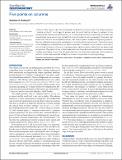Five points on columns
Author(s)
Rockland, Kathleen
DownloadRockland-2010-Five points on columns.pdf (1.454Mb)
PUBLISHER_POLICY
Publisher Policy
Article is made available in accordance with the publisher's policy and may be subject to US copyright law. Please refer to the publisher's site for terms of use.
Terms of use
Metadata
Show full item recordAbstract
“Column,” like “gene,” has both conceptual and linguistic shortcomings. The simple question “what is a column” is not easy to answer and the word itself is not easy to replace. In the present article, I have selected five points, in no way comprehensive or canonical, but which may nevertheless serve as a prompt and aid for further discussions and re-evaluation. These are: that anatomical columns are not solid structures, that they are part of locally interdigitating systems, that any delimited column also participates in a widely distributed network, that columns are not an obligatory cortical feature, and that columns (as “modules”) occur widely in the brain in non-cortical structures. I focus on the larger scale macrocolumns, mainly from an anatomical perspective. My position is that cortical organization is inherently dynamic and likely to incorporate multiple processing styles. One can speculate that the distributed mappings within areas like piriform cortex may resemble at least one mode of neocortical processing strategy.
Date issued
2010-06Department
Picower Institute for Learning and Memory; RIKEN-MIT Center for Neural Circuit GeneticsJournal
Frontiers in Neuroanatomy
Publisher
Frontiers Media
Citation
Rockland, Kathleen S. “Five Points on Columns.” Frontiers in Neuroanatomy (2010)
Front. Neuroanat. 4:22 Copyright: © 2010 K. S. Rockland
Version: Final published version
ISSN
1662-5129